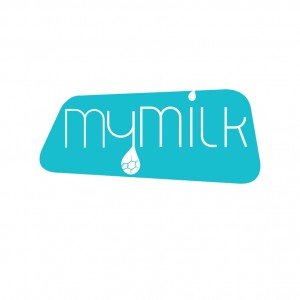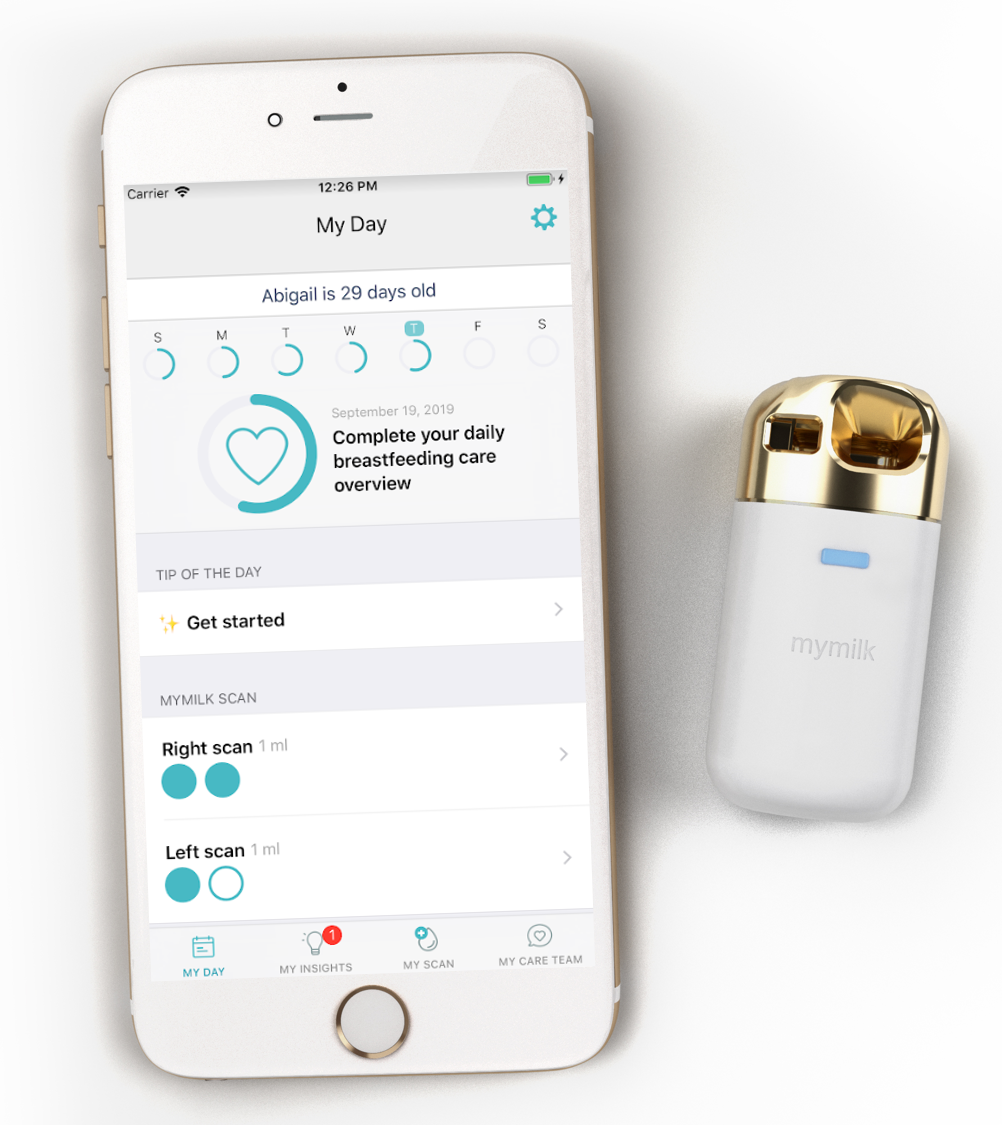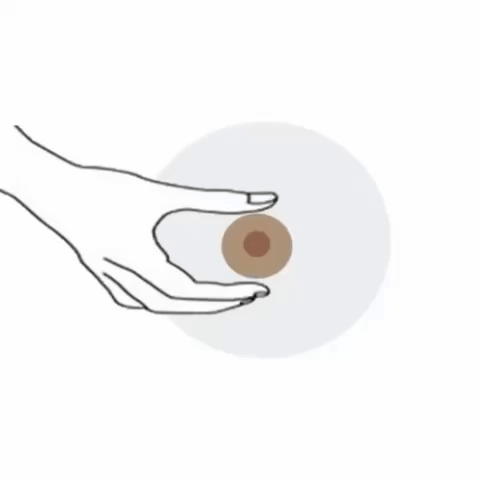

By inserting just several milk drops into the device daily, and app interaction, you can see your day-to-day progress and get personal tips.
The MyLee is in beta testing. You can join!
In the first weeks of breastfeeding, milk is produced in the mother’s breast through a demand and supply mechanism, so that the mother develops the breast infrastructure for milk production and produces milk in accordance with the latch and milk transfer stimulus. But this does not happen over-night, it is a process. Getting breastfeeding established takes a ‘time investment’ and the first days-weeks can be challenging. Here we discuss some of the basics
Frequent breastfeeding, starting from the moment of birth, is of great importance in creating the abundance of milk for continued breastfeeding. The more you breastfeed in the first few days, the more your body will produce milk according to the rising demand of the baby.
Breastfeeding in the first few days can get long and it is important that you are comfortable. make sure your back is supported, you have armrests and your feet can be raised. When you are sitting comfortably, attach the baby to you so that her ear, waist and pelvis are in a straight line and she is supported on your abdomen. If breastfeeding while lying down, pillows that support the back and a pillow between the knees can be helpful. If you had a caesarean section: Ask for help in a position and use a pillow, so that breastfeeding will not be painful on your insition.
Proper latch allows the baby to grasp as much of the areola as possible with her lower jaw, and is central to good breast grip. Wait until the baby opens a large mouth, as if yawning, then bring the baby to the breast in a swift motion. If you start breastfeeding when her nose is in front of your nipple, when she opens her mouth to start suckling, the lower jaw and lip will be the first to touch. When taking the breast properly, the nipple ends up very deep in the baby’s mouth (soft pellet). Often, especially in the first few weeks, it is usually necessary to support the breast in order to achieve good latch. In this case, support the breast from below with your thumb on one side of the areola and palm and four fingers on the base of the breast, a light compression of the breast will allow a good grasp by the baby’s mouth. Place the fingers as far away from the areola as possible.
The baby better detach on her own will. If it is necessary to detach the baby from the breast before she has finished breastfeeding, the vacuum she creates can be “broken” by gently pulling her lower lip or gently inserting your little finger at the corner of her mouth. Do not pull the baby from your nipple while it is attached as this may be painful and cause injury and wounds. In the first few days, the first seconds of breastfeeding can be painful. Most of this pain passes after a few days (if the pain persists, or is particularly strong, it is advisable to consult a lactation consultant about the position and the possibility of a tongue-tie in the baby). If you worry about the grip being shallow, or you are very uncomfortable, or experiencing strong pain, gently release and re position. It is important to make sure that the baby correctly grasps the areola and nipple to allow effective suckling, for avoiding wounds and ensure good milk flow.
This is a good thing if your baby wants to eat “all the time”. The more your baby is breastfed in the first few days (i.e .: more than 8 times in 24 hours) the greater the chance that she will not lose excessive percentages of weight, which will reduce the chance of developing neonatal jaundice. Do not hesitate to breastfeed your baby whenever she seems interested even if she just finished breastfeeding. Breastfeeding sessions can be very long, even an hour long, but can also be very short – a few minutes, and it varies between different mothers, babies, and sessions.
Breast stimulation is helpful in establishing breastfeeding and increasing milk production. If baby is sleepy, you should protect your supply and expedite milk coming in by adding manual milk expressions between breastfeeding attempts. For a low weight baby, baby that is not awake enough to feed at least 8 times a day, and in case of low blood glucose, or jaundice, there may be a need to add early pumped milk feeds.
Place the baby on the breast and/or place the baby skin-to-skin on your chest, belly to belly, wearing only a diaper (if it is cool, cover both of your bodies with a blanket), as often as you can.
The baby’s contact with your body and the stimulus of the breast contributes to the success of breastfeeding by increasing the secretion of hormones necessary for the production of milk and the maturation of breast tissue. In addition, when a baby is in skin-to-skin contact with you, the baby will suckle more often and it will be easier for you to identify her signs of hunger and when she is ready for the next breastfeeding even before she cries.
Skin-to-skin contact can be made even when she is connected to monitors. If you had a caesarean section, ask for help in a position that will not hurt you in the suture area. You can place a pillow or blanket on the incision area.
Giving bottles and pacifiers, before breastfeeding has established may really impair breastfeeding. Suckling on a pacifier or bottle nipple is completely different from breastfeeding. Using a pacifier can interfere with the baby’s messaging of hunger cues and thus can cause weight loss / improper weight gain due to insufficient breastfeeding. Using a bottle in the first few days can also cause a lack of stimulation of the mother’s breast, interfere with the baby grasping the nipple correctly, can cause milk supply insufficiencies, and pain for the mother. If you choose to give your baby a pacifier or a bottle, it is recommended that you do so when breastfeeding is already well established, when your baby is about four to six weeks old.
In the first hours and days after birth (in some cases even before birth) you may need to hand express to collect colostrum for feeding your baby, this may be needed in case of separation between mother and baby, if the baby is sleepy, in late pre-term babies, in cases of low glucose or Jaundice, and after a C section.
Hand expressing colostrum and milk in the first days may actually be more productive than breast pumping.
Also when everything is going well, hand milk expression between feeds on the first hours and days postpartum was shown by research to improve production, improve milk volumes, enhance milk coming in and improve baby’s weight gain, and improve overall breastfeeding success.
Hand milk expression can be an efficient way to reduce breast engorgement and prevent milk stasis, therefore helping prevent breast inflammation.
Hand expression done correctly should not be painful. It may take several trials to get comfortable. Don’t expect more than a few drops initially, it is OK! It improves with every drop and with practice.
♥️YOU GOT THIS!


Snapshot from MyMilk breastfeeding guide
Link to educational video by Dr. Jane Morton From Stanford Medicine – HAND EXPRESSION EDUCATIONAL VIDEO